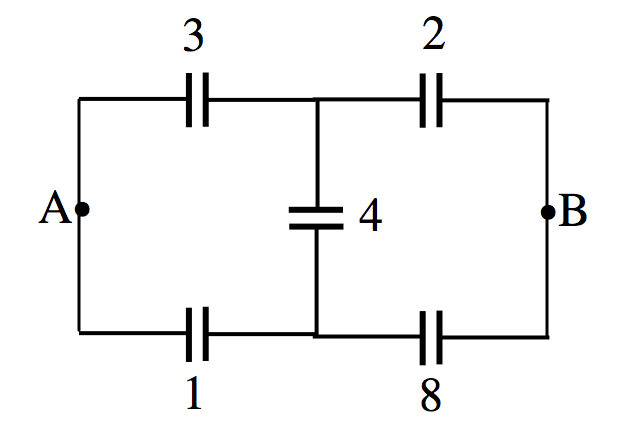5.7: Transformación Delta-Star
- Page ID
- 131712
\( \newcommand{\vecs}[1]{\overset { \scriptstyle \rightharpoonup} {\mathbf{#1}} } \)
\( \newcommand{\vecd}[1]{\overset{-\!-\!\rightharpoonup}{\vphantom{a}\smash {#1}}} \)
\( \newcommand{\id}{\mathrm{id}}\) \( \newcommand{\Span}{\mathrm{span}}\)
( \newcommand{\kernel}{\mathrm{null}\,}\) \( \newcommand{\range}{\mathrm{range}\,}\)
\( \newcommand{\RealPart}{\mathrm{Re}}\) \( \newcommand{\ImaginaryPart}{\mathrm{Im}}\)
\( \newcommand{\Argument}{\mathrm{Arg}}\) \( \newcommand{\norm}[1]{\| #1 \|}\)
\( \newcommand{\inner}[2]{\langle #1, #2 \rangle}\)
\( \newcommand{\Span}{\mathrm{span}}\)
\( \newcommand{\id}{\mathrm{id}}\)
\( \newcommand{\Span}{\mathrm{span}}\)
\( \newcommand{\kernel}{\mathrm{null}\,}\)
\( \newcommand{\range}{\mathrm{range}\,}\)
\( \newcommand{\RealPart}{\mathrm{Re}}\)
\( \newcommand{\ImaginaryPart}{\mathrm{Im}}\)
\( \newcommand{\Argument}{\mathrm{Arg}}\)
\( \newcommand{\norm}[1]{\| #1 \|}\)
\( \newcommand{\inner}[2]{\langle #1, #2 \rangle}\)
\( \newcommand{\Span}{\mathrm{span}}\) \( \newcommand{\AA}{\unicode[.8,0]{x212B}}\)
\( \newcommand{\vectorA}[1]{\vec{#1}} % arrow\)
\( \newcommand{\vectorAt}[1]{\vec{\text{#1}}} % arrow\)
\( \newcommand{\vectorB}[1]{\overset { \scriptstyle \rightharpoonup} {\mathbf{#1}} } \)
\( \newcommand{\vectorC}[1]{\textbf{#1}} \)
\( \newcommand{\vectorD}[1]{\overrightarrow{#1}} \)
\( \newcommand{\vectorDt}[1]{\overrightarrow{\text{#1}}} \)
\( \newcommand{\vectE}[1]{\overset{-\!-\!\rightharpoonup}{\vphantom{a}\smash{\mathbf {#1}}}} \)
\( \newcommand{\vecs}[1]{\overset { \scriptstyle \rightharpoonup} {\mathbf{#1}} } \)
\( \newcommand{\vecd}[1]{\overset{-\!-\!\rightharpoonup}{\vphantom{a}\smash {#1}}} \)
Como hicimos con las resistencias en la Sección 4.12, podemos hacer una transformada delta-estrella con capacitores.

\(\text{FIGURE V.7}\)
Dejo al lector demostrar que la capacitancia entre dos terminales cualesquiera en la caja de la izquierda es la misma que la capacitancia entre los dos terminales correspondientes en la caja de la derecha siempre que
\[c_1=\frac{C_2C_3+C_3C_1+C_1C_2}{C_1},\label{5.7.1}\]
\[c_2=\frac{C_2C_3+C_3C_1+C_1C_2}{C_2},\label{5.7.2}\]
\[c_3=\frac{C_2C_3+C_3C_1+C_1C_2}{C_3},\label{5.7.3}\]
Las relaciones contrarias son
\[C_1=\frac{c_2c_3}{c_1+c_2+c_3},\label{5.7.4}\]
\[C_2=\frac{c_3c_1}{c_1+c_2+c_3},\label{5.7.5}\]
\[C_3=\frac{c_1c_2}{c_1+c_2+c_3},\label{5.7.6}\]
Por ejemplo, sólo por diversión, ¿cuál es la capacitancia entre los puntos A y B en la Figura\(V.8\), en la que he marcado las capacitancias individuales en microfaradios?

\(\text{FIGURE V.8}\)
Los tres primeros condensadores están conectados en delta. Reemplácelos por su configuración de estrella equivalente. Después de eso debería ser sencillo. Hago la respuesta 2.515\(\mu F\).


